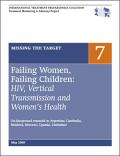Publications - Released in 2009
Governments and UN agencies have failed to meet their international commitments and should be called to account. Despite the relative ease of delivering the antiretroviral prophylaxis to prevent vertical transmission progress has been slow, with global coverage rising from 9 percent in 2004 to 33 percent coverage in 2007. At least three quarters of HIV-positive pregnant women in 61 countries, including Cameroon, Ethiopia, India and Nigeria, are still not receiving this intervention.
Moreover, it is not enough merely to ensure access to ARV prophylaxis. Quality is equally important, and in this regard too the options for women in poorer countries are far less appropriate and effective. In the developed world, all women who want and need ARV prophylaxis can obtain triple-dose combination therapy, which reduces the risk of vertical transmission to a mere 2 percent. About half of women receiving ARV prophylaxis in the global South, meanwhile, are provided with single-dose nevirapine treatment. This regimen reduces transmission risk by just over 40 percent, however, and puts women under the risk of developing resistance to nevirapine, which is the backbone of many HIV treatment regimens in general.
Our research for this report, Missing the Target 7, has reinforced the need for governments, UN agencies, donors and indeed civil society to look beyond the magic bullet of administering a pill each to mother and baby in order to stem the annual toll of preventable infections and deaths in newborns.
Downloads
Organizations
- International Treatment Preparedness Coalition (ITPC)






